Managing software updates is a critical part of running a modern IT infrastructure. Software updates are essential for keeping your system secure and stable and are the primary way of adding new features to your systems.
Patch management is a centralized procedure used to oversee, control, and automate patching activity at both small and large businesses. The patch management software maintains logs, generates reports, updates the status with pending, success, and failure, and does much more. It sends updates and hotfixes throughout the entire network based on IP ranges, without flooding the network.
Patch management software aids large corporations, and SMBs to develop well-managed infrastructures that yield optimal performance, better security, and less system downtime. Additionally, patch management tools also help with patching network equipment, which is a crucial component of IT infrastructure.
As per one of the latest reports, patch management software’s market size is anticipated to grow at a CAGR of 10.7%, from USD 652 million in 2022 to USD 1084 by 2027.
Best Patch Management Software
ManageEngine
The all-purpose patching solution, ManageEngine Patch Manager Plus, is available both locally and in the cloud. It offers automatic patch deployment solutions for Linux, macOS, and Windows operating systems. Because it supports 850+ third-party applications, it can practically support all your products and applications.
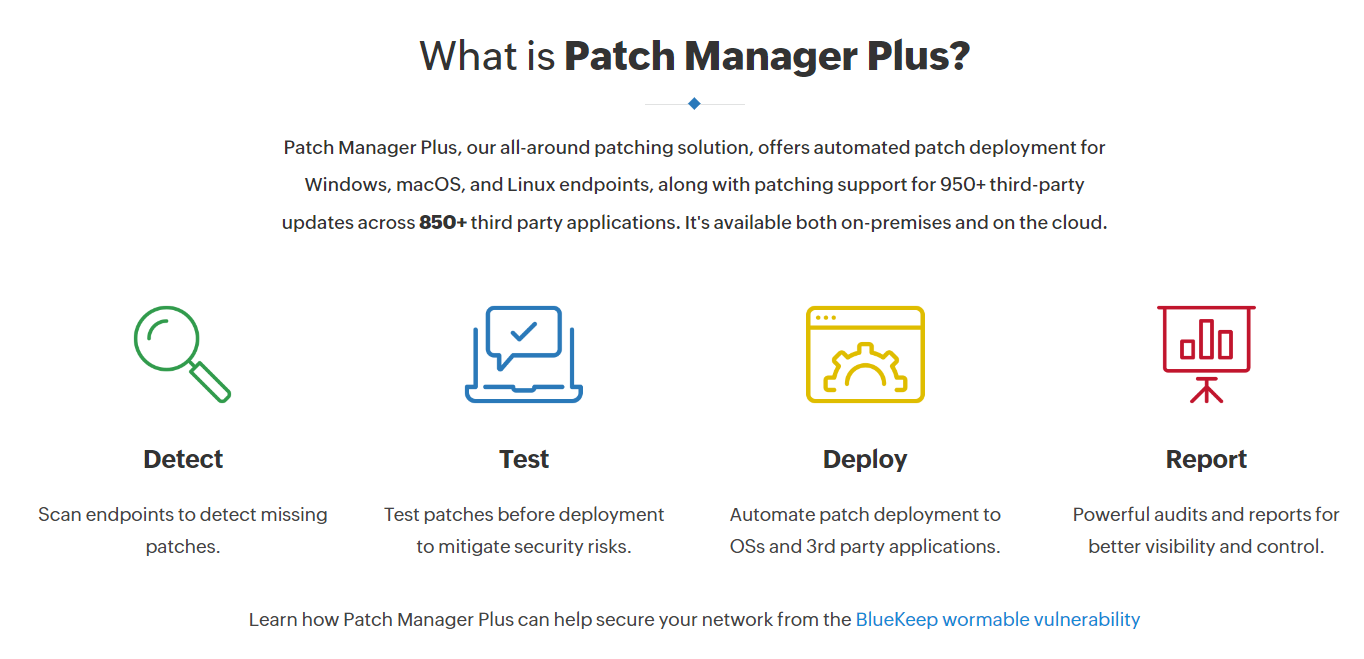
Top Features
- To ensure that the operating system, applications, and business services are not impacted, patches can be tested before being deployed.
- Automated patch deployment in a hybrid environment.
- Extensive reports to improve patch visibility.
- Prebuilt and tested packages for deployment in the network.
The software serves as a one-stop-shop for comprehensive patching solutions. Because of its sophisticated features, like Patch compliance, two-factor authentication, and a distribution server for bandwidth optimization, it is an excellent choice for both SMBs and large corporations.
Scalefusion
A complete and comprehensive patch management solution for Windows devices is the Scalefusion Windows patch management software. It is made to rapidly and easily identify, examine, accept, schedule, and apply patches across any number of Windows devices.
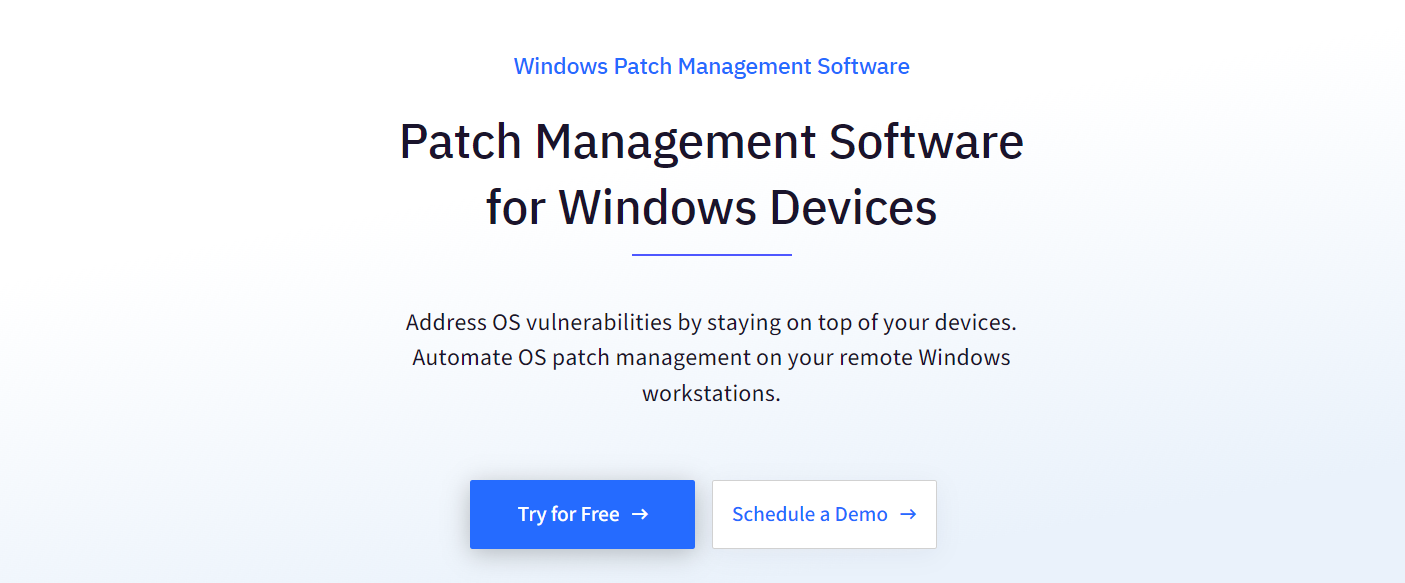
This safe approach allows IT administrators to manage devices, security rules, and software upgrades from a single console. Scalefusion offers IT administrators powerful control features like on-premise deployment, app banning, device lockdown, and remote access.
IT administrators can be confident that their systems and data are very safe by utilizing Scalefusion. It facilitates the deployment and management of third-party upgrades on Windows 11, 10, 8.1, 8, and 7 devices with a single click.
Top Features
- Quickly identify vulnerabilities
- Anticipate threats and prevent them before they happen
- Provides comprehensive reporting to keep informed
- Speedier patch deployment with automation
Scalefusion offers comprehensive information and insights into the patching process and lets you define unique patching procedures following the requirements of each device. Organizations may easily set up, update, and patch their PCs remotely using the Scalefusion Web-based GUI.
Heimdal
Heimdal Patch & Asset Management is a scalable and intuitive solution providing system administrators with a powerful vulnerability management tool and software asset inventory under one unified roof. This automatic software updater handles both operating system-specific patches, as well as proprietary and third-party patches on the go, according to any deployment schedule and from anywhere around the globe.

Together with the optional Infinity Management module available in Heimdal’s patch manager, sysadmins also gain the ability to deploy custom, in-house updates outside of the base product’s catalog. Available on Windows, Linux, and Mac, the tool thus IT teams valuable time and resources, automating update deployment flows entirely and allowing them to focus on other tasks.
Top Features
- Upgrades or downgrades between software and operating system version with ease.
- Deploys proprietary operating system and third-party software to every endpoint, anywhere in the world.
- Grants complete visibility into any software assets, complete with version and installed volume information.
- Helps create complete inventory reports for compliance demonstration purposes.
- Allows for the creation of custom update deployment schedules at any given date and time.
Relying on the traditional system and software updates just don’t cut it anymore. Between the myriad of tasks admins juggle daily, there is little bandwidth left sometimes to deal with patching. Heimdal Patch & Asset Management solves this issue by automating every single step of the process, making it the ideal choice for companies looking to streamline and unify cybersecurity operations efficiently.
SuperOps
SuperOps is a unified PSA-RMM platform that includes all of the features that an MSP needs to manage the facilities of a client.
Powered with the goodness of AI and intelligent automation, SuperOps is packed with all the features and tools that a modern MSP needs, including project management and IT documentation.
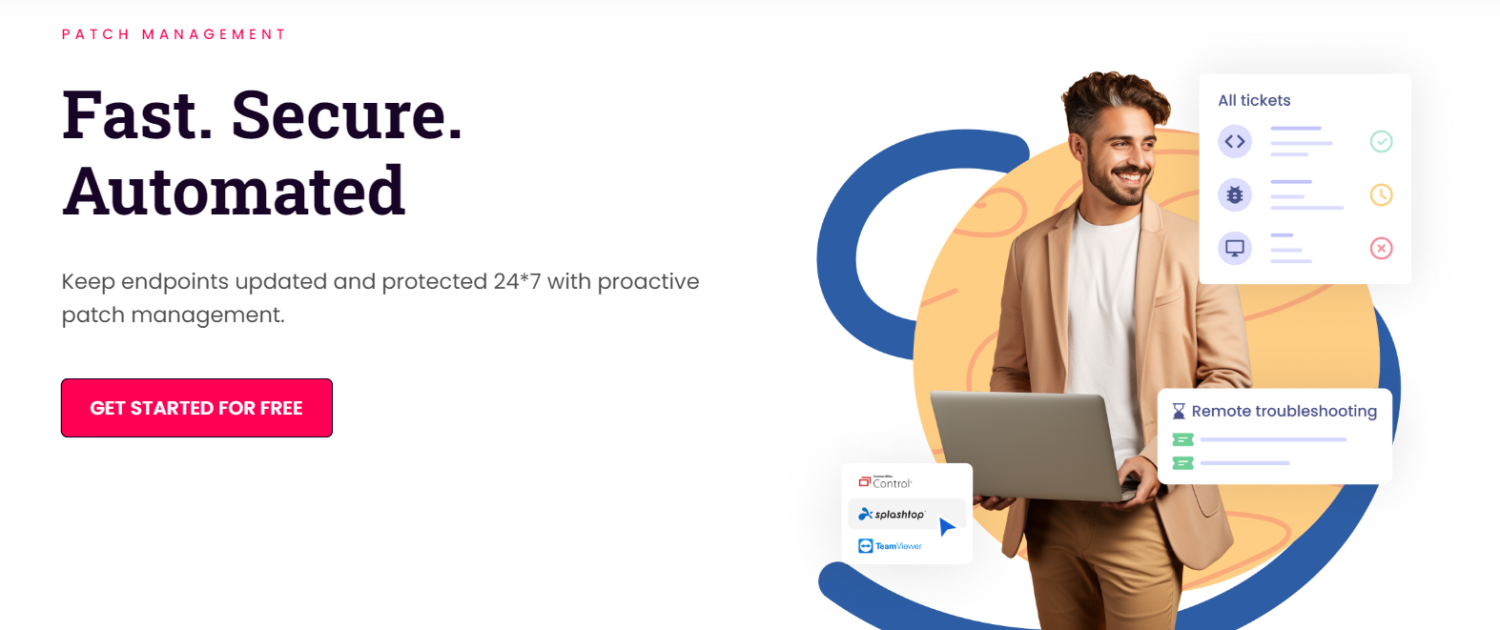
With SuperOps’ patch management, you can manage a wide variety of operating systems, including Windows, Mac, Linux, UNIX, IOS, Android, and others, and applications. It also offers workflows that manage the patch management process from identification through testing, approval, and deployment.
Features
Vulnerability management: Manage hundreds of patches released to remediate vulnerabilities found in operating systems and applications.
Endpoint management: Effectively manage endpoint devices and ensure they are running as the expected operating system and application versions and alert technicians when they are not.
Governance tools: Ensure compliance through reports and periodic audits and safe and up-to-date management of the computing environment.
SecPod SanerNow
An advanced vulnerability and patch management platform, SecPod SanerNow completely automates your patch management process and simplifies it. SecPod SanerNow can patch all major OSs like Windows, Linux, and macOS, and 400+ unique 3rd party apps and their versions (most in the industry). It is available as cloud and on-premise variants.
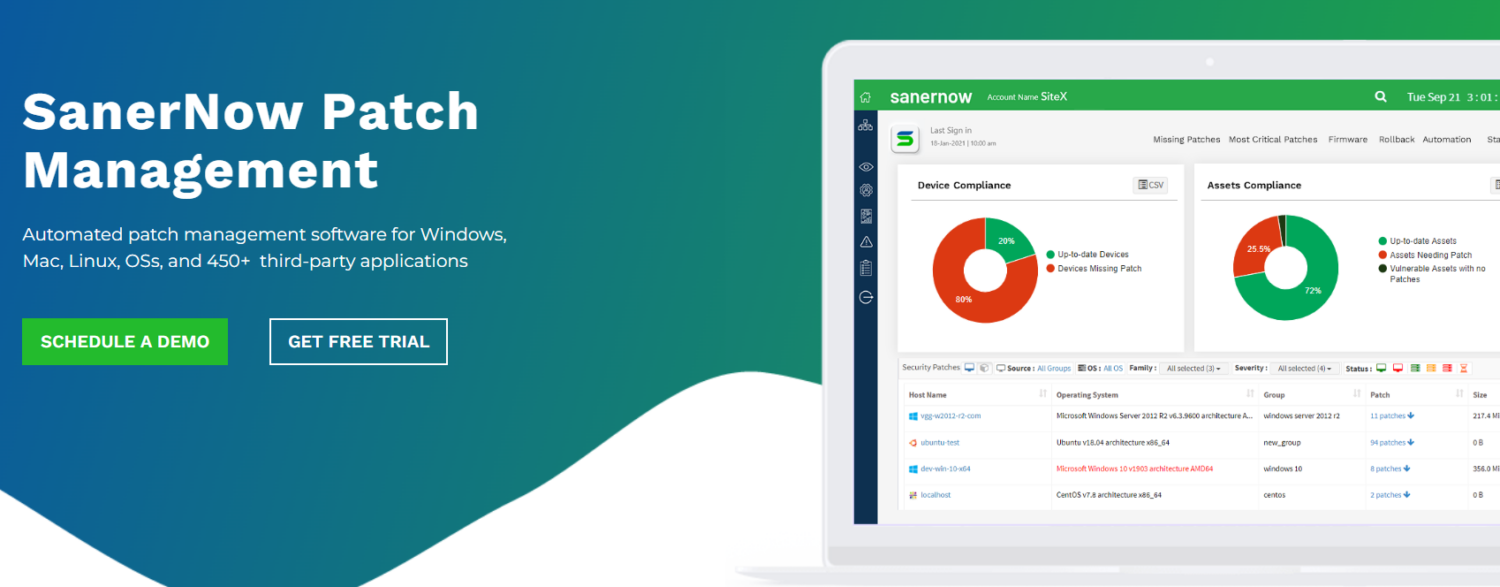
Top Features
- Automated and scheduled patching to achieve patch compliance
- Supports all major OSs and 400+ unique third-party apps, most in the industry
- Firmware and driver patches deployment
- Roll back software patches in case of software malfunctions or failure
- Insightful and customizable reports on critical vulnerabilities and patches in your network
SanerNow’s security-driven patching also ensures that vulnerabilities are remediated. You can correlate the patching status with vulnerabilities in the next scan and ensure that the security risk is eliminated. SanerNow simplifies patch management and boosts security by 6 times.
NinjaOne
G2 and Gartner Digital Markets rank NinjaOne as the best remote monitoring and management tool. Through automation and administration of patch management, this cutting-edge and user-friendly tool aids IT teams in increasing efficiency and productivity.

Since it is entirely cloud-based, patching may be done without the necessity of complicated servers. The program streamlines all IT processes and lessens the time-consuming task of patching the entire IT portfolio.
It has a central console that displays the health and performance of all systems and identifies exposed and secured devices. To safeguard the environment, the platform aids in the identification of vulnerabilities, their eradication, and blocklisting.
Top Features
- The platform is simple to use in terms of patch identification, approval, deployment, and reporting.
- Helps to minimize cyber-attacks by automatically updating 135 widely used programs.
- Almost immediately finds and patches vulnerabilities.
- Enables real-time monitoring of patch compliance.
NinjaOne is the finest option if you’re searching for an award-winning, user-friendly patching platform that can patch any IT environment, including Windows, Mac, and Linux systems. The admins can try the software free of cost before deployment in the live network.
Jetpatch
The patch management program Jetpatch has grown to be one of the most widely used products available. In physical, virtual, and cloud environments, it offers a solitary platform to handle patch deployments and compliance requirements.
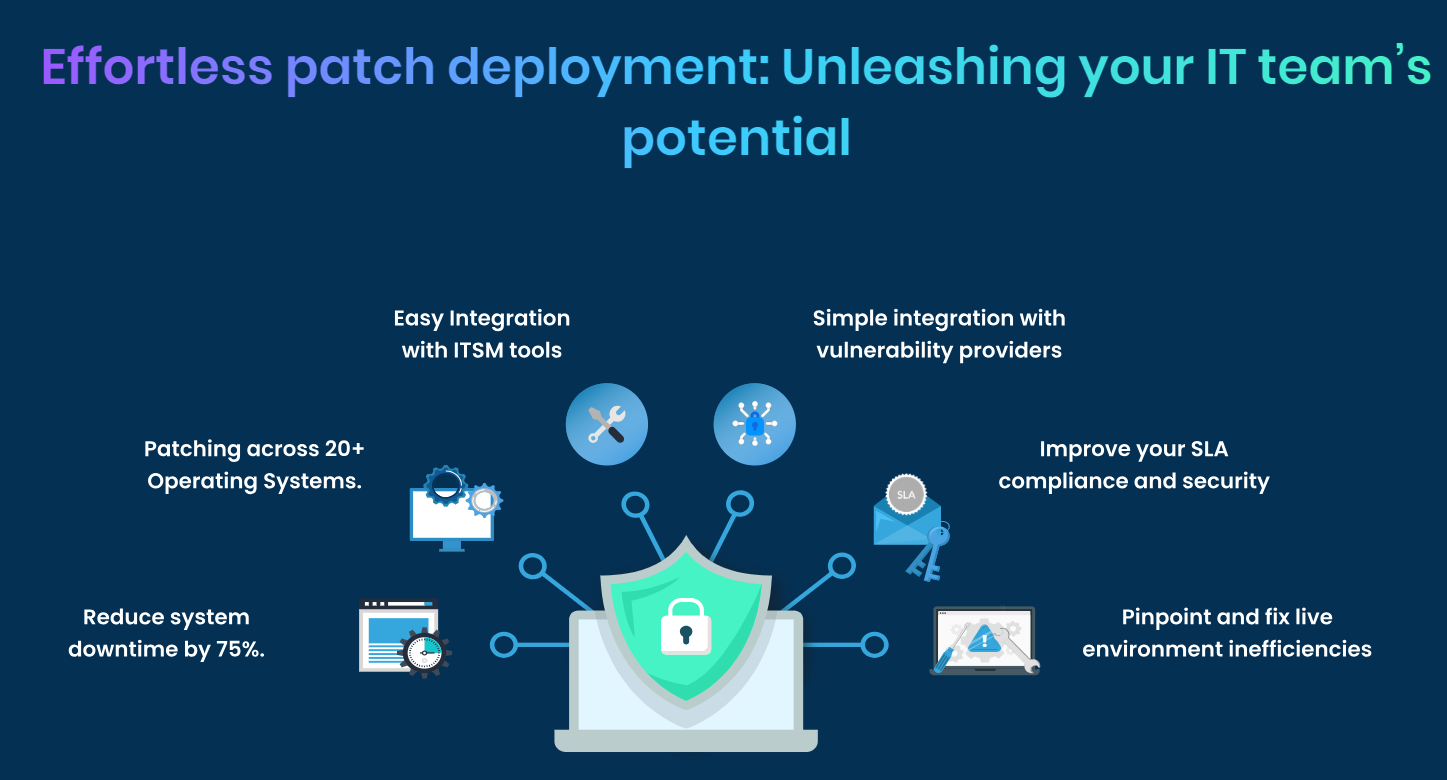
The platform offers SMBs an easy approach to locating vulnerabilities, fixing them, and automating patch deployment throughout the whole organization.
This software’s ability to evaluate and understand the underlying reasons for remediation delays and then automatically fix them leads to patching optimization
Top Features
- To determine the need for patching, the entire IT infrastructure is automatically discovered.
- Real-time patching helps keep systems updated and reduces the risk of security breaches.
- The patch remediation process may be seen and analyzed using its patch governance dashboard.
One of the most effective patch automation tools is Jetpatch, which automates all patching procedures and vulnerability remediation across the infrastructure to save time and eliminate mistakes. Before deploying the software on the network, the IT team can test it for free.
Automox
Automox is the industry-leading cloud-native patch management software for automatic patching and configuration management without an on-premises server, thus saving time and money.
According to its website, the program reduces operational overhead by 80%, enabling the IT team to function more efficiently without overburdening the patch administration.

Additionally, it is the only patch management solution with integrated security, compliance, and governance features that help businesses comply with laws like the Gramm-Leach-Bliley Act (GLBA), Health Insurance Portability, and Accountability Act (HIPAA).
Top Features
- As it is cloud-based, there are no maintenance or administrative costs.
- The platform supports hybrid environment patching, including Windows, macOS, and Linux systems.
- Deployment of other scripting solutions like configuration policies.
- Unaffected by domain location, systems can be patched, inventoried, generated in various reports, and checked for vulnerability status using a single interface.
Traditional patching methods struggle to maintain infrastructure costs and understaffed businesses; the Automox platform helps solve these issues. It offers more effective and affordable ways to handle the dynamic patching environment of today and manage escalating contemporary difficulties.
Action1
A cloud-based software called Action1 Patch Management was created to assist businesses in effectively managing the patching process and reducing cyber security concerns. The platform aids in automating the patching procedure, which cuts down on the time and effort needed to maintain the systems.
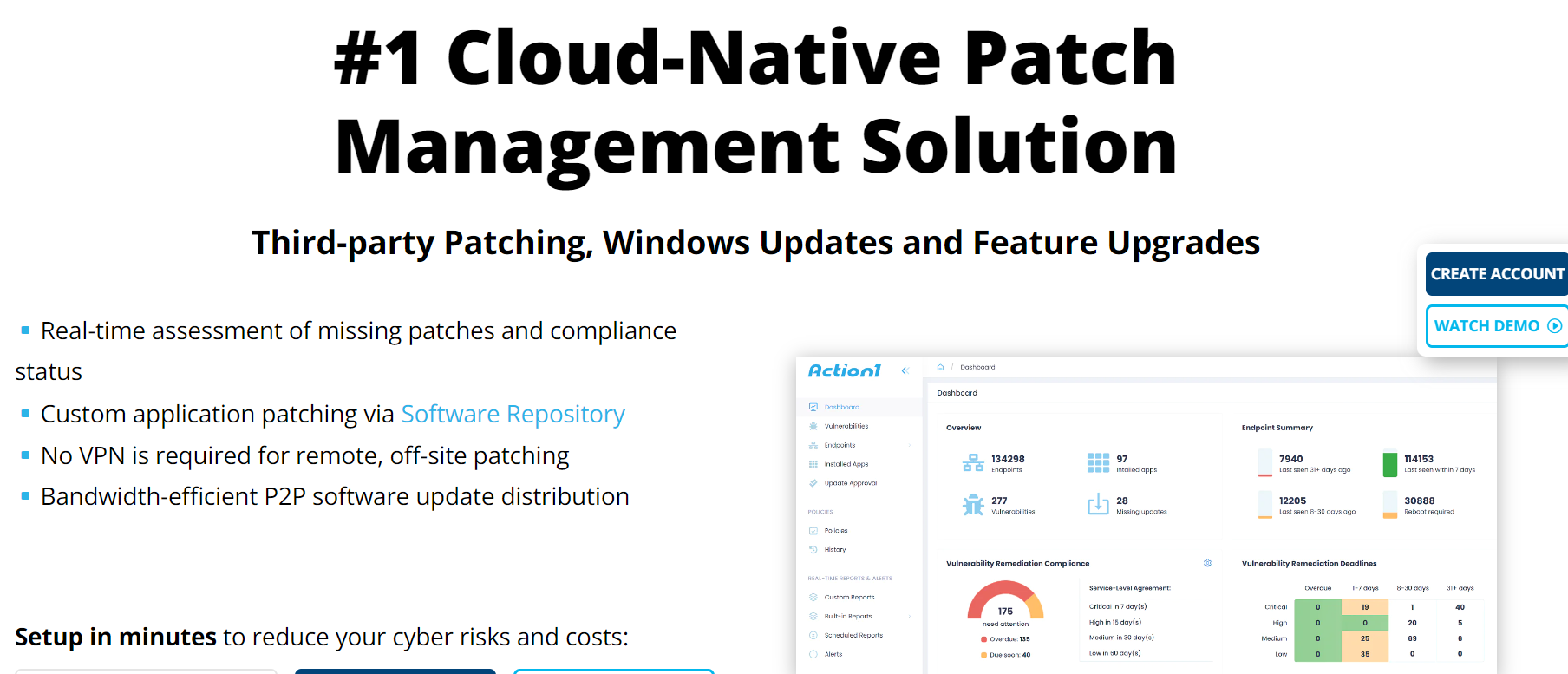
Additionally, the platform offers businesses a centralized location to manage vulnerabilities across all of their systems—both modern and legacy—helping them better understand their security posture and prioritize their requirements.
The Action1 patch management software includes all features needed for the whole patch management procedure to protect your endpoints and prevent vulnerability exploitation.
It provides complete visibility on missing updates such as windows KBs, hotfixes, security patches, OS fixes, and third-party software updates.
Top Features
- The platform provides a complete patching solution, from identifying missing patches to producing reports.
- Total control over the patching process, including scheduling, approval, and denial
- Systems can be patched regardless of the domain’s location without a VPN connection.
- Rather than waiting for the discovery and distribution of patches, a reliable scan mechanism can find any immediate pending updates.
This all-in-one patch set uses a single cloud-based platform to update systems accessible to a hybrid workforce working remotely or in an office from almost anywhere in the world. Its compliance reports assist in meeting the legal requirements, and its patching policy mandates the implementation of corporate security.
Jumpcloud
Jumpcloud is a versatile platform that enables businesses of all sizes to deploy and keep up with patches for their complex infrastructure. In terms of patch management, configuration management, and security, the platform offers the highest levels of automation, consistency, and effectiveness.

Its streamlined patch management console gives insight into the operating system, browsers, and applications that are currently running in your infrastructure. It also automates patching to keep your devices secure and up to date.
The platform offers a single screen for monitoring a hybrid environment that includes Windows, macOS, Ubuntu Linux, browsers, and applications.
Top Features
- The ability to easily add, modify, remove, and schedule patch entries are very flexible.
- Strengthens application, browser, and device security with continuous patch deployment with low IT intervention.
- Utilize real-time data of hybrid devices to spot potential dangers and halt shutdown threats.
- The platform offers Active Directory, Google Workspace, and Microsoft 365 directory-level interoperability.
Jumpcloud patch management software provides customized actions and even automatic enforcement triggers based on user behavior to ensure 100% compliance without clogging network resources.
GFI LanGuard
To monitor, secure, and keep up with patch management requirements for endpoint protection across the network, GFI LanGuard patch management software offers extensive auditing and patch management capabilities.

To protect the network, the software connects with 4000 security products, including firewalls, anti-phishing programs, antivirus software, and others.
This platform’s database contains an updated list of more than 60,000 known issues, which makes it one of a kind and makes it easier to directly fix vulnerabilities. Additionally, the software offers security reports that assist in maintaining compliance with various standards, including PCI DSS, HIPAA, and SOX.
Top Features
- A vulnerability database with over 11,500 checks that continuously protect the system
- An indicator graph that displays the threat to your scanned devices
- Employs a secure HTTPS connection for a web-based reporting interface.
- Scanning for vulnerabilities on hardware components like switches, access points, routers, etc.
This flexible patch management software enables the installation of more than one software in big networks and allows them to control from a single central interface.
Its robust reporting features enable you to combine several reports and export them to different formats based on your needs. The software can be used for free for 30 days.
Atera’s Patch Management
With Atera’s Patch Management Software, IT staff can manage all the organization patches completely from a single console.
By automating OS, software, and hardware patches, admins can save time while maintaining security and control. You can also keep track of every agent with the use of powerful reporting.
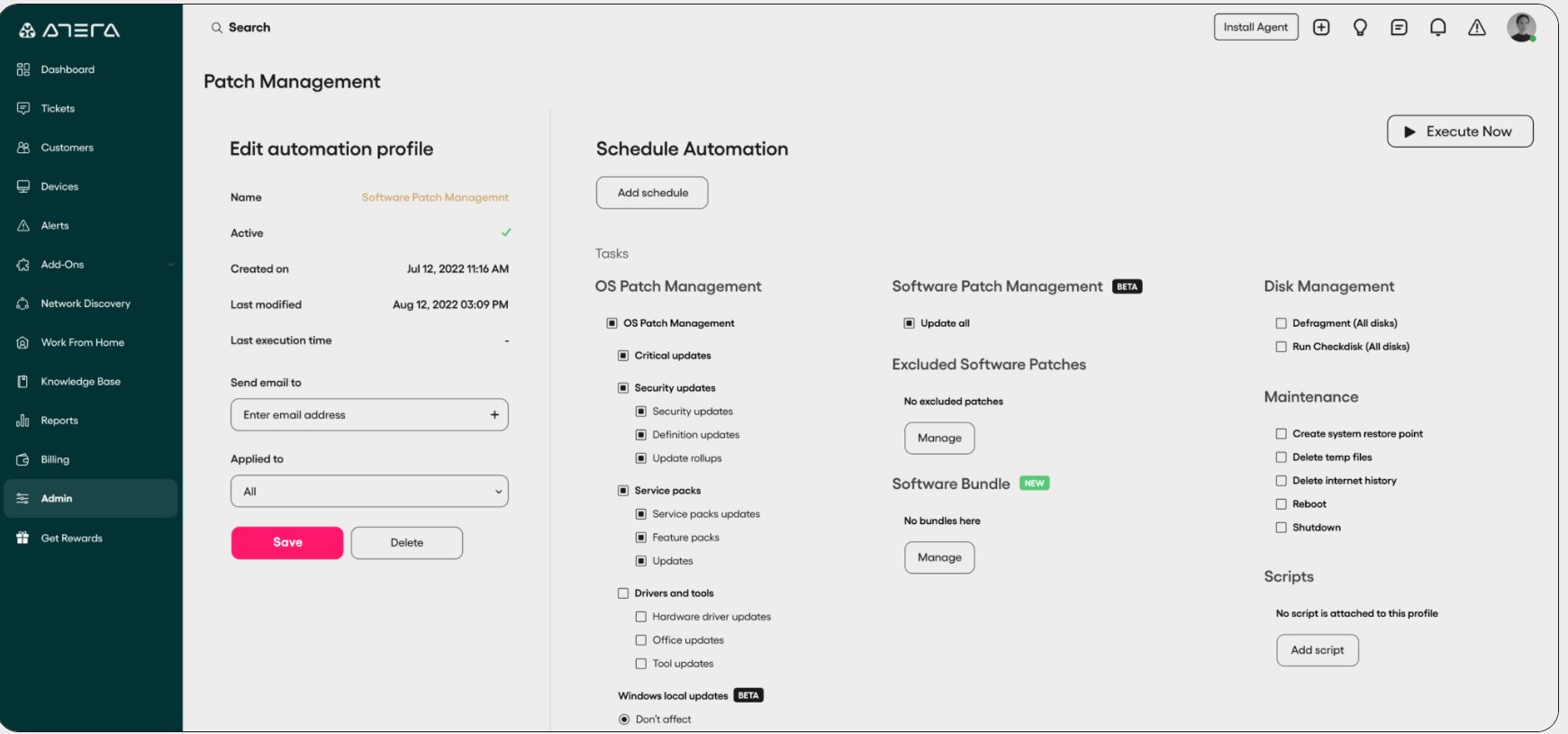
Atera keeps an extensive script database that is utilized for intelligent automation and is completely tailored to the demands of the organization. These scripts can be used to complete a number of activities, including eliminating bloatware applications, deleting event logs, updating drivers, and more.
Top Features
- Installing Microsoft and other third-party updates with effective IT automation.
- A provision to install any updates that are missing from the reporting console and precise reporting based on knowledgebase, description, or agent type.
- Control and scheduling of all patches from one central location.
Patch management is one of Atera’s modules, which is an RMM (remote monitoring and management) platform. The software offers a platform that enables you to do your task more quickly and effectively, including robust ticketing, remote monitoring and management, customer feedback gathering, network discovery, billing and invoicing, and much more.
SolarWind Patch Manager
SolarWinds Patch Manager helps to save time and makes it simpler to maintain your servers and workstations patched and compliant. The scheduling, deployment, reporting, and other elements of the patch management process are greatly streamlined.
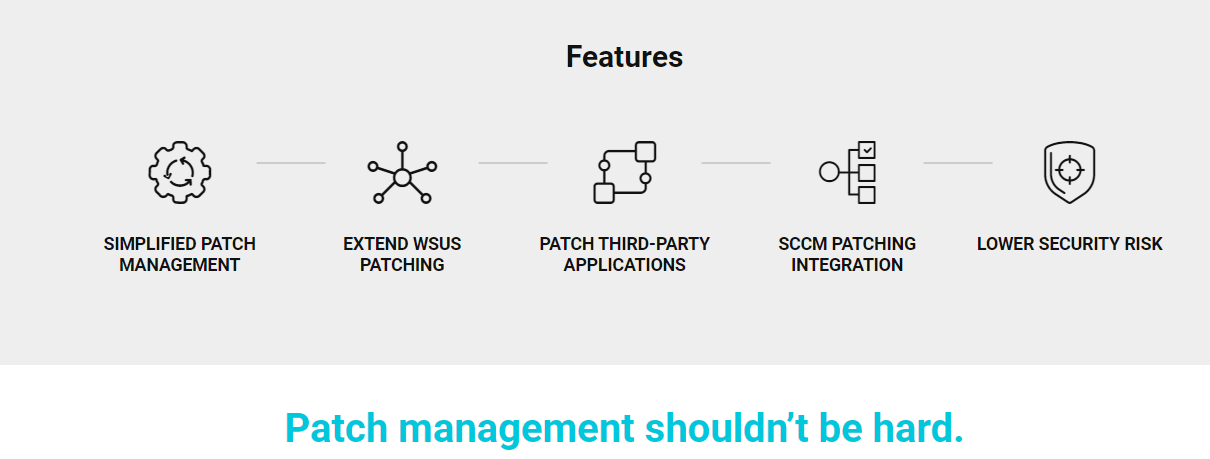
Its distinctive web portal offers a bird’s-eye view to monitoring the patching environment in terms of patch success, failure, and rescheduling if necessary, among other things. Package Boot technology is built into the software to guarantee that security packets are successfully distributed to prevent vulnerabilities.
SolarWinds Patch Manager allows admins to schedule the deployment of patches during low traffic or non-working hours to avoid network congestion.
Top Features
- Patches are simply chosen, approved, and scheduled for deployment.
- Simple to enhance and integrate existing Microsoft WSUS and SCCM features (System Center Configuration Manager).
- Easy to patch virtual systems and inventory virtual machines across your enterprise.
- New patch notification and classification according to security, critical, definition, and third-party updates.
In addition to the listed features above, SolarWinds offers a robust reporting feature that enables administrators to monitor the status of all patches and assist enterprises in demonstrating patch compliance to auditors. Before making a purchase, administrators can use the full software version for free for 30 days.
Ivanti
Ivanti’s Patch for Endpoint Manager offers a fully end-to-end patch management solution for all OS and apps in the IT infrastructure, thus ensuring that the systems receive full protection.
It offers fast and comprehensive vulnerability discovery on Windows, macOS, and Linux, plus hundreds of third-party applications. This expertly pre-tested deployment ensures that every system receives essential patches promptly.

The software enables setting consistent policies for all assets, including mobile or remote devices, to ensure complete patch coverage across your organization. It can identify and fix vulnerabilities not only from the operating system but also at the third-party app level through a one-window process by looking at multi-operating system details in no time.
It helps to comply with law and regulatory requirements, reducing the negative impact through staged rollouts approved by the change boards.
In addition, the automation feature is a way to ensure control over the pace of patching is fully efficient.
| ✅ Pros | ❌ Cons |
|---|---|
| Swiftly detects vulnerabilities in OS and Apps | It will be pricey for small business |
| Automated prevention, detection, and response | Reports lack granular details |
| Integration with Configuration Manager |
Kaseya
VSA Patch Management is one of the conceptualized offerings by Kaseya in a bid to automate and standardize software maintenance efforts with heterogeneous environments. Development of this tool has been conceptualized with the idea of easing patch deployment with the help of easy-to-use policy profiles on the one hand and addressing complexities related to the same on the other.
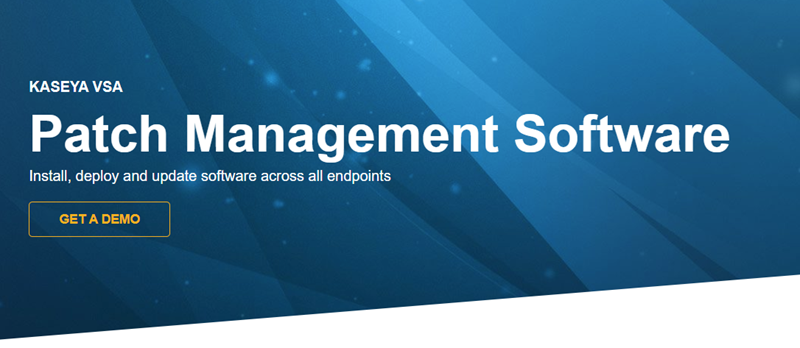
The software will keep updating all the patches, so no critical vulnerability is missed out to be in full control with the scripting autopilot.
Its policy profiles expertly expound on the process of patch deployment by affording you a user-friendly solution for handling approvals, scheduling, and installations. What is more, its advanced features afford you an opportunity to deny specific patches or block certain updates on the machines selected, while overriding classifications of patches default.
How does Patch Management work?
Let’s first examine what a patch is before learning about patch management. The patches are essential software updates deployed to fix bugs or update existing programs or applications.
Patches are released by software providers to correct defects, improve performance, strengthen security, and address vulnerabilities. Patching is a crucial step in IT infrastructure to prevent cyber-attacks, reduce risk, prevent significant outages, and improve software and application reliability.

The SMB (small to medium business) and large companies have specific IT rules and policies to maintain the consistency of applications and software versions to be part of the audit process.
Windows patch management
Microsoft WSUS (Windows Server Update Services) is one of the well-known patch management software developed by Microsoft to patch Windows systems. WSUS provides a user-friendly console to patch Microsoft systems, while it’s a bit inflexible to patch third-party applications such as Adobe, Java, Oracle, and others.

Limitation of WSUS
WSUS has a few limitations, some of which are listed below, even though it is a free tool that works well with the Windows operating system or other Microsoft products:
- If the environment is hybrid, its involvement is minimal
- Limited ability to patch applications from third parties
- The reporting system is inadequate
Conclusion
Business should ensure to keep infrastructure and applications up-to-date by deploying the right patch management software. Most of the above offer trial, so the best is to try some of them and pick the one that works for you and fits your budget.
You can trust Geekflare
At Geekflare, trust and transparency are paramount. Our team of experts, with over 185 years of combined experience in business and technology, tests and reviews software, ensuring our ratings and awards are unbiased and reliable. Learn how we test.

